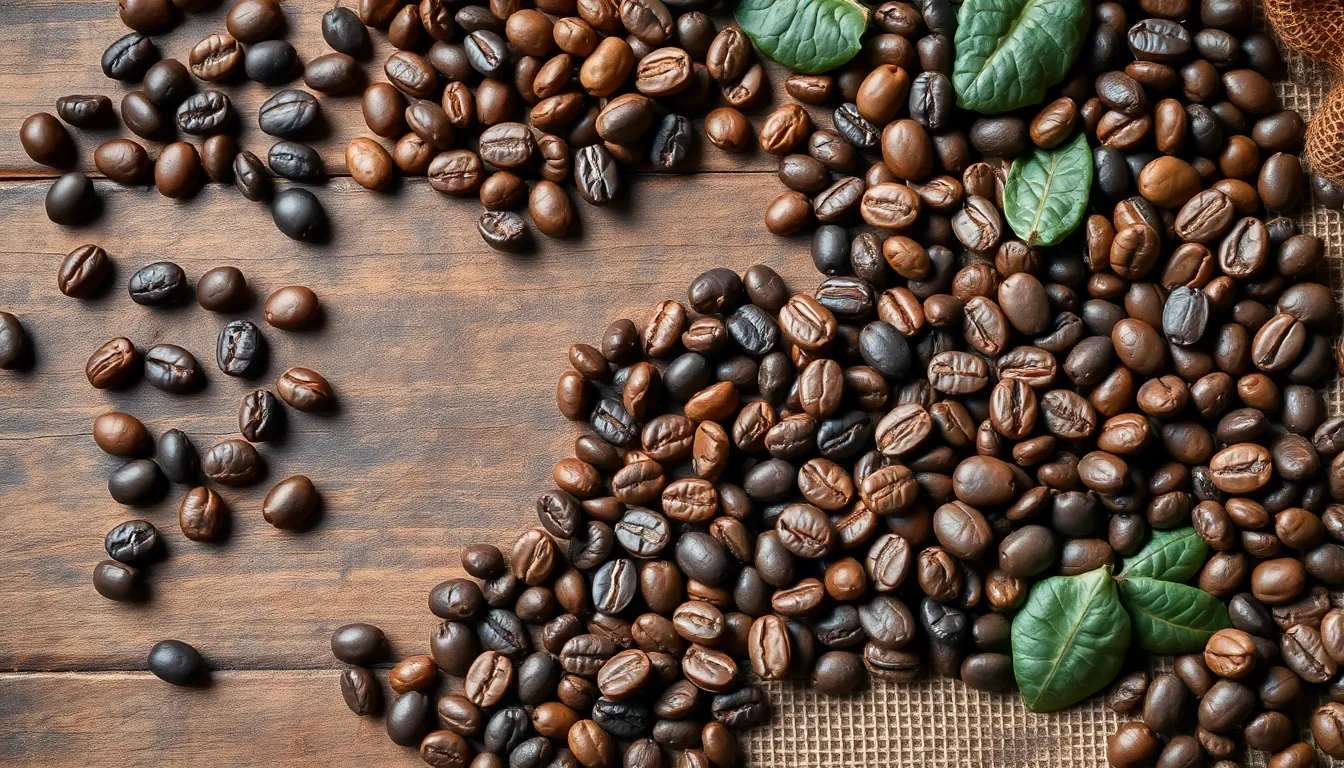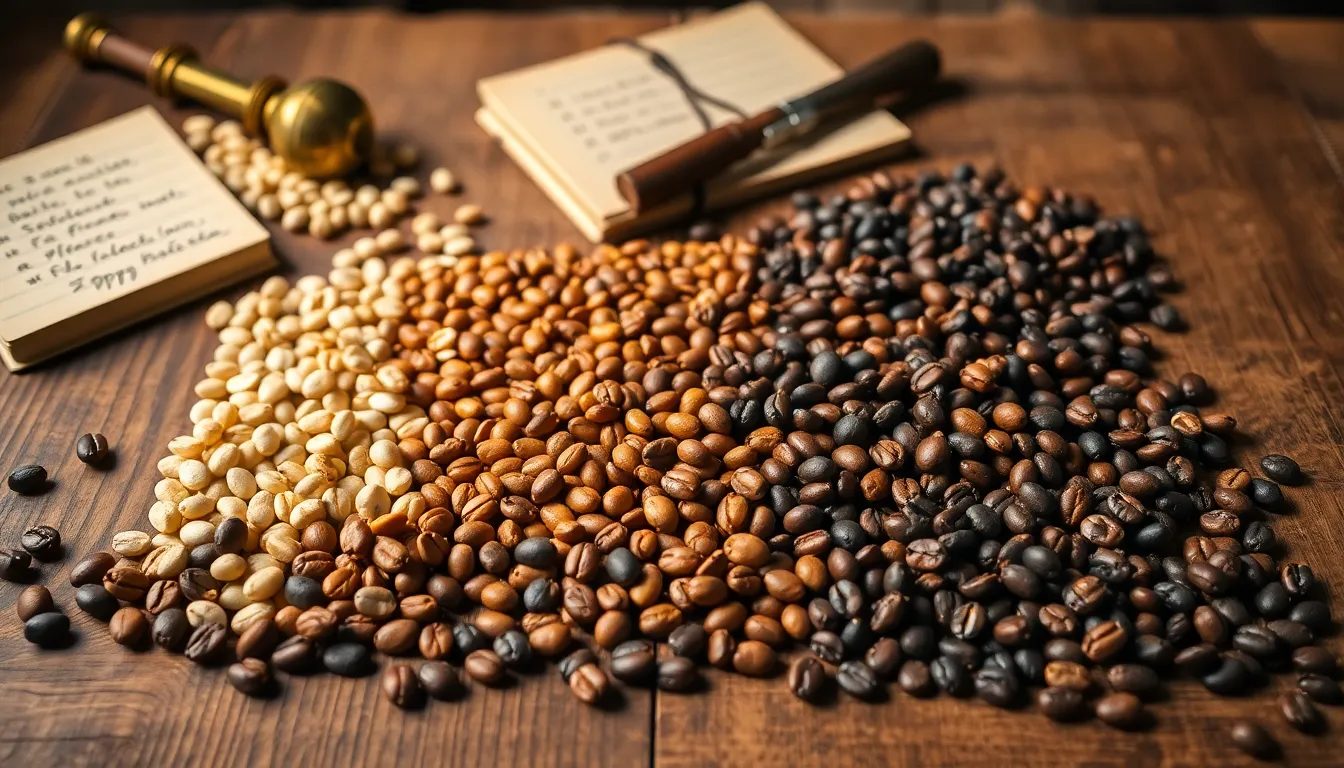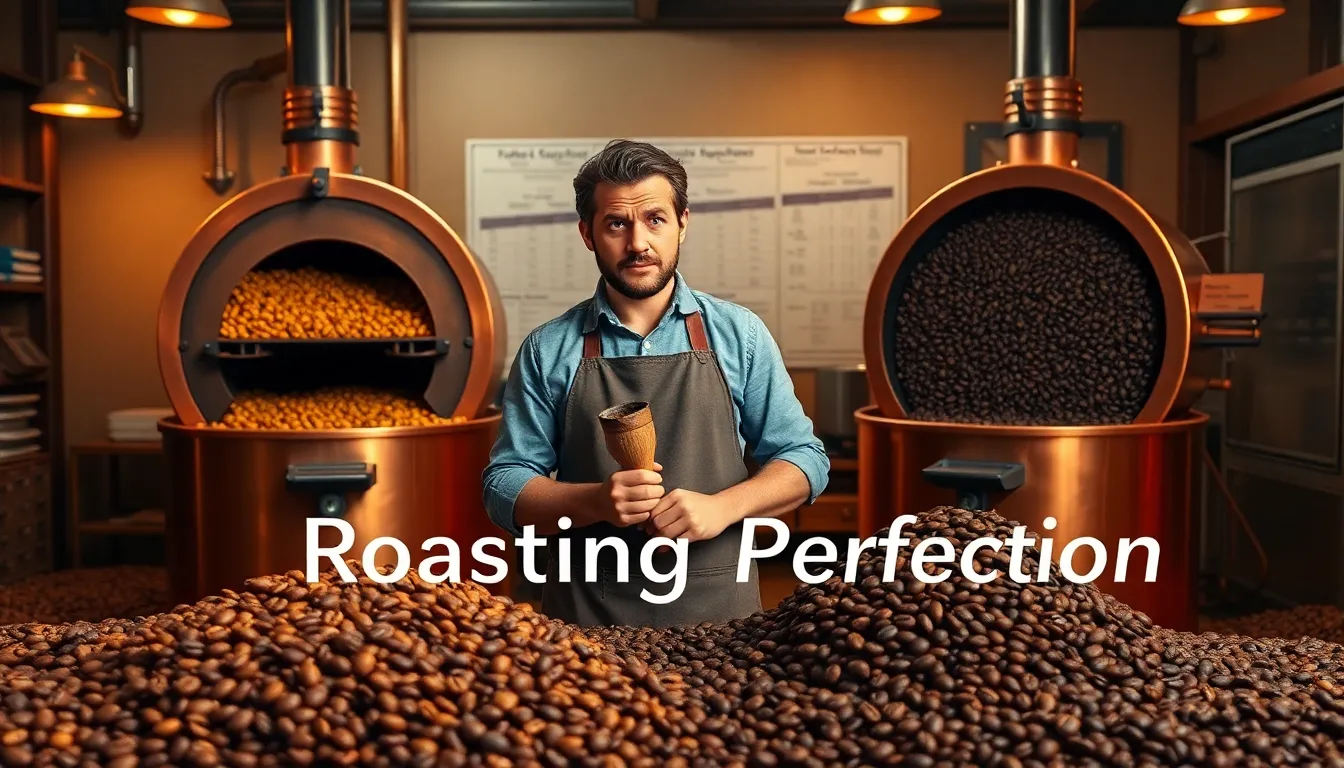Introduction to Coffee Bean Roasting
Did you know that over 2.25 billion cups of coffee are consumed globally every day? Behind every perfect cup lies an intricate art form: coffee bean roasting. This transformative process turns ordinary green coffee beans into the aromatic, flavorful beans that fuel your morning routine. Whether you’re a casual coffee drinker or an aspiring home roaster, understanding the science and technique of roasting can elevate your coffee experience from mundane to extraordinary.
Table of Contents
What is Coffee Bean Roasting
Coffee bean roasting is the crucial process of heating green coffee beans to transform their chemical and physical properties. By applying precise heat, you unlock the beans’ hidden flavors, aromas, and complex characteristics that define your coffee’s final taste profile.
The Science Behind Roasting
Roasting coffee is a complex scientific transformation. When beans are heated, they undergo a series of chemical reactions called the Maillard reaction and caramelization. These processes break down sugars, create new flavor compounds, and develop the rich, complex taste that coffee lovers crave. Temperature, duration, and roasting method dramatically influence the final flavor profile.
Why Roasting Matters for Flavor
Roasting isn’t just a step in coffee preparation—it’s the key to unlocking flavor. Different roast levels fundamentally change how your coffee tastes. Light roasts preserve more of the bean’s original characteristics, while dark roasts create bold, intense flavors with reduced acidity. Understanding roasting helps you craft the exact taste experience you desire.
Understanding Coffee Bean Varieties

As the legendary coffee enthusiast James Hoffmann once said, “Coffee is a journey, not a destination.” Understanding coffee bean varieties is the first step in transforming your brewing experience. Each bean tells a unique story of origin, processing, and potential flavor, making the world of coffee an exciting exploration for enthusiasts and casual drinkers alike.
Different Types of Coffee Beans
Coffee beans are not created equal. Globally, there are four primary types of coffee beans: Arabica, Robusta, Liberica, and Excelsa. Each variety brings its own distinctive characteristics to your cup, influencing everything from flavor intensity to caffeine content. Understanding these differences can help you select the perfect beans for your preferred brewing method.
Arabica vs. Robusta
When it comes to coffee beans, Arabica and Robusta are the two heavyweight champions. Arabica beans are known for their smooth, complex flavors and lower caffeine content, while Robusta beans pack a punch with higher caffeine and a more robust, sometimes bitter taste. Here’s a quick comparison:
| Characteristic | Arabica | Robusta |
|---|---|---|
| Flavor Profile | Sweet, Soft | Strong, Bitter |
| Caffeine | Lower | Higher |
Origin and Flavor Characteristics
Your coffee’s flavor is deeply rooted in its origin. Beans from different regions offer unique taste experiences. For instance, Ethiopian beans often present fruity and floral notes, while Colombian beans tend to be nutty and well-balanced. Factors like altitude, soil composition, and local climate contribute to these distinctive flavor characteristics.
Selecting the Right Beans for Roasting
Selecting the right beans is an art form. Consider your brewing method, flavor preferences, and roast level. Fresh, high-quality beans are crucial for an exceptional cup. Look for beans with a recent roast date, and don’t be afraid to experiment with different origins to discover your perfect coffee profile.
Home Coffee Roasting Methods

Home coffee roasting is an exciting journey that transforms you from a casual coffee drinker to a true coffee artisan. By roasting your own beans, you’ll unlock a world of fresh flavors and aromas that commercially roasted coffee can’t match. Whether you’re a beginner or looking to refine your skills, understanding the basics of home roasting will revolutionize your coffee experience.
Roasting Equipment Options
Choosing the right roasting equipment is crucial to your coffee roasting success.
Your roasting method can significantly impact the final flavor and quality of your beans.
From professional-grade drum roasters to simple home solutions, you’ll find an option that fits your budget, space, and coffee passion.
Drum Roasters
Drum roasters are the gold standard for home coffee roasting enthusiasts. These machines use a rotating drum that ensures even heat distribution and consistent roasting. Professional-grade models allow precise temperature control, giving you the ability to create perfect roast profiles for different bean varieties.
Air Roasters
Air roasters, also known as fluid bed roasters, use hot air to roast and move beans simultaneously. This method provides quick and even roasting with excellent heat control. Ideal for those who want a more hands-on approach, air roasters are typically more compact and easier to clean compared to traditional drum roasters.
Skillet and Oven Roasting
Don’t have specialized equipment? No problem! Skillet and oven roasting are budget-friendly alternatives for home coffee roasters. Using a heavy skillet or baking sheet, you can achieve decent results with careful monitoring. Just be prepared for some smoke and ensure good ventilation during the process.
Step-by-Step Roasting Process
Roasting coffee is a precise art that requires attention to detail. The step-by-step process involves careful bean selection, controlled heating, and precise timing.
Each stage of roasting transforms the beans’ flavor, aroma, and chemical composition.
Understanding these steps will help you create the perfect roast every time.
Preparing Your Beans
Preparing your coffee beans is more than just grabbing a bag off the shelf. Select high-quality, fresh green beans from reputable suppliers. Check for uniformity in size and color, and ensure they’re free from defects. Proper bean selection is the foundation of an exceptional roast.
Roasting Techniques
Roasting techniques vary from light to dark roasts, each bringing out different flavor profiles.
- Light roasts preserve more original bean characteristics
- Medium roasts balance original flavors with roasting notes
- Dark roasts create bold, intense flavors
Experiment to find your perfect roast level!
Cooling and Storing Roasted Beans
After roasting, proper cooling and storage are critical to maintaining your beans’ quality. Cool beans quickly to stop the roasting process, and store in an airtight container away from light and moisture. Freshly roasted beans peak in flavor 24-72 hours after roasting, so plan your brewing accordingly.
Roast Levels and Flavor Profiles

When it comes to brewing the perfect cup of coffee, understanding roast levels is crucial. Roasting transforms green coffee beans into the aromatic, flavorful beans we know and love. Each roast level brings out unique characteristics that can dramatically change the taste, aroma, and overall coffee experience. Whether you’re a home brewing enthusiast or a coffee connoisseur, mastering the art of roasting will elevate your coffee game and help you discover your ideal flavor profile.
Understanding Roast Levels
Roast levels are essentially the degree to which coffee beans are heated during the roasting process. They range from light to dark, with each level significantly impacting the bean’s flavor, acidity, and body. The roasting process involves carefully controlled temperature and timing to develop the beans’ complex flavor compounds.
Light Roast Characteristics
Light roast coffee is characterized by its light brown color and lack of oil on the bean’s surface. These beans are roasted for the shortest time, preserving the bean’s original flavor characteristics. You’ll notice a bright, acidic taste with subtle, complex flavor notes. Light roasts typically have higher caffeine content and showcase the unique origins of the coffee beans, making them perfect for single-origin coffees.
Medium Roast Characteristics
Medium roast coffee strikes a perfect balance between flavor and roasting intensity. These beans have a richer brown color and a more balanced flavor profile. You’ll experience a smooth, well-rounded taste with reduced acidity compared to light roasts. Medium roasts bring out a more developed sweetness and complexity, making them a crowd-pleaser for many coffee drinkers.
Dark Roast Characteristics
Dark roast coffee is characterized by its deep brown, almost black color and oily surface. Roasted for the longest time, these beans have a bold, robust flavor with low acidity. You’ll taste strong, bitter notes with hints of smokiness and chocolate. Dark roasts are less complex but deliver a powerful, intense coffee experience that many espresso and French press lovers appreciate.
Matching Roast Levels to Brewing Methods
Different brewing methods shine with specific roast levels. Light roasts work best with pour-over or drip methods, medium roasts are versatile for most brewing techniques, and dark roasts excel in espresso and French press. Understanding this connection helps you choose the right beans and brewing method to create your perfect cup of coffee.
Common Roasting Mistakes and Tips

When it comes to roasting coffee beans, even experienced home roasters can fall into common pitfalls that compromise the quality of their brew. Understanding these mistakes is crucial to elevating your coffee roasting skills. From uneven heat distribution to incorrect timing, there are several critical errors that can turn your potential flavor masterpiece into a bitter disappointment. By recognizing and addressing these common challenges, you’ll be well on your way to creating consistently delicious, perfectly roasted coffee beans that bring out the most vibrant and complex flavors.
Troubleshooting Roasting Issues
Roasting coffee is an art that sometimes encounters unexpected challenges. Troubleshooting roasting issues requires a keen eye and understanding of the roasting process. Whether you’re dealing with inconsistent bean color, unusual flavors, or unexpected smoking, there are systematic approaches to diagnose and resolve these problems. Pay close attention to your roasting equipment, bean quality, and technique to ensure you can quickly identify and correct any issues that arise during the roasting process.
Avoiding Uneven Roasting
Uneven roasting can be the bane of any coffee enthusiast’s existence. To avoid this common pitfall, you’ll need to focus on several key factors. Ensure your roasting surface provides consistent heat distribution, frequently stir or agitate the beans during roasting, and use high-quality equipment that allows for uniform heat exposure. A carefully managed roasting process means each bean receives equal attention, resulting in a batch with consistent color, flavor, and aroma.
Preventing Burnt Beans
Preventing burnt beans requires precision and careful monitoring. Watch your temperature and timing closely, as even a few seconds can transform perfectly good beans into a burnt, bitter mess. Use a reliable thermometer, stay attentive throughout the roasting process, and learn to recognize the signs of over-roasting. Remember, the line between a perfectly roasted bean and a burnt one is incredibly thin, so patience and practice are your best tools in avoiding this roasting disaster.
Pro Tips for Perfect Roasting
Professional coffee roasters have a wealth of knowledge that can transform your home roasting experience. These pro tips go beyond basic techniques, offering insights into bean selection, roasting nuances, and flavor development. From understanding bean origins to mastering subtle temperature adjustments, these expert strategies will help you elevate your roasting game and create coffee with depth, complexity, and incredible taste.
Temperature Control
Temperature control is the cornerstone of exceptional coffee roasting. Precise heat management allows you to develop specific flavor profiles and ensure consistent results. Invest in a reliable roasting thermometer, learn to make minute adjustments, and understand how different temperatures affect bean characteristics. Whether you’re aiming for a light, medium, or dark roast, mastering temperature control is crucial to bringing out the best in your coffee beans.
Timing and Listening for Cracks
The subtle art of timing and listening for coffee roasting cracks is like a secret language for coffee enthusiasts. First and second cracks are crucial indicators of the roasting progress, signaling key stages in flavor development. Train your ear to distinguish between these sounds, and you’ll gain invaluable insight into the perfect roasting moment. Timing is everything – listen carefully, and your beans will tell you exactly when they’re ready.
Conclusion: Mastering the Art of Coffee Roasting
As you’ve journeyed through the intricate world of coffee roasting, you’ve gained valuable insights into transforming simple green coffee beans into rich, aromatic treasures. Mastering the art of coffee roasting is more than just a skill—it’s a passion that connects you to centuries of coffee craftsmanship. By understanding the nuanced techniques, flavor profiles, and roasting principles, you’ve taken a significant step towards becoming a true coffee connoisseur.
Recap of Key Roasting Principles
Remember the key principles: temperature control, bean selection, and roasting time are your primary tools in creating the perfect roast. Each stage—from first to second crack—dramatically influences the final flavor, allowing you to craft everything from light and bright to deep and robust coffee profiles.
Continuing Your Coffee Roasting Journey
Your coffee roasting journey doesn’t end here—it’s just beginning! Continue experimenting with different bean origins, invest in quality roasting equipment, and never stop learning.
Great coffee is an art, and you are the artist.
Join local roasting communities, attend workshops, and keep pushing the boundaries of your coffee roasting skills.
